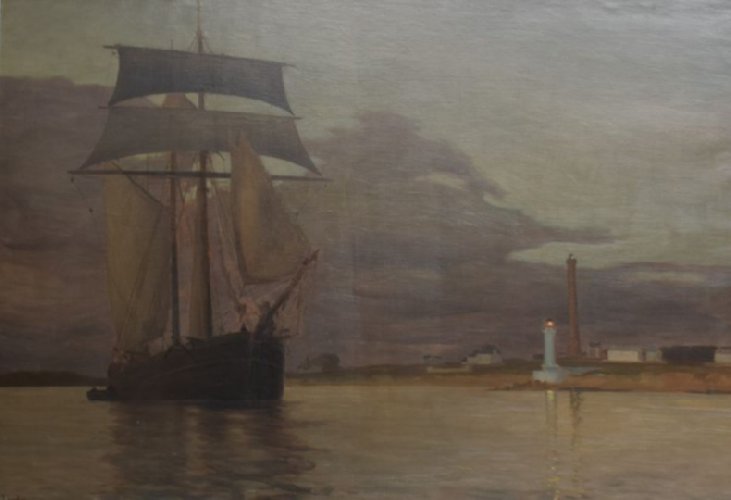Description:
André Dauchez (1870-1948) was a French painter. He studied in Paris under his future brother-in-law, Lucien Simon. He was drawn to the Breton theme under his influence and joined “La Bande Noire”, where he worked alongside such artists as Edmond Aman-Jean, Émile-René Ménard, Charles Cottet and Maurice Denis. He was a member of the Société Nationale des Beaux-Arts. In the 1890s he created graphics, often based on his maritime paintings. From 1922 to 1932 he was the official painter of the French Navy*.
Description of the painting:
We remain in the circle of Breton views. This time André Dauchez focuses on showing a more urbanized and industrialized part of the Breton coast. A sailing ship is leaving the port. He leaves behind a city adorned with pointedly marked white walls of two-story houses in the distance.
The painting captures the moment when dawn is most likely to break. The brightening sky gives a sign to spread the sails. The whole presentation is surrounded by the remnants of the early morning fog. Two lighthouses are clearly outlined on the right side of the picture field. With their reflections in the water, they become vertical, compositional complements to the sailboat seen on the other side. The ship passes them, heading towards the open ocean.
The painting captures the moment when dawn is most The symbolic light of the two lighthouses is a guarantee of a safe return. It is lit just after dusk and extinguished when dawn begins. In Dauchez’s view, it seems to light up the last beats of the night sky. It is an unambiguous sign of human intervention. On the one hand, disturbing the eternal laws of nature, on the other symbolizing the struggle with the element only partially tamed, so constantly dangerous. The sky brightening in the upper part of the painting increases the impression of gradual thinning of the air and announces a successful journey. The rising sun covers the mirror of the water with a golden glow. The sailing ship depicted by the artist is located in the Bénodet Bay. The lighthouses visible in the background flank the mouth of the Odet river*.likely to break. The brightening sky gives a sign to spread the sails. The whole presentation is surrounded by the remnants of the early morning fog. Two lighthouses are clearly outlined on the right side of the picture field. With their reflections in the water, they become vertical, compositional complements to the sailboat seen on the other side. The ship passes them, heading towards the open ocean.
The painting is a pendant to Dauchez’s painting “At the Turn”*. A pendant is a work that is a compositional equivalent of another representation. Most often, in addition to the thematic, coloristic and compositional similarity, the same or very similar format of work appears. These paintings are usually hung symmetrically**. The work, along with the presentation entitled “At the Turn”, was presented at the Salon of the Société Nationale des Beaux-Arts in 1897.


